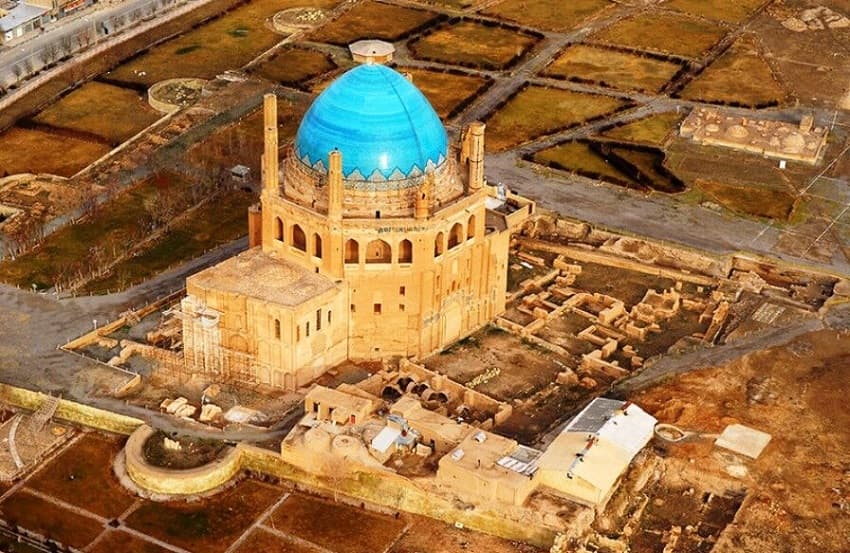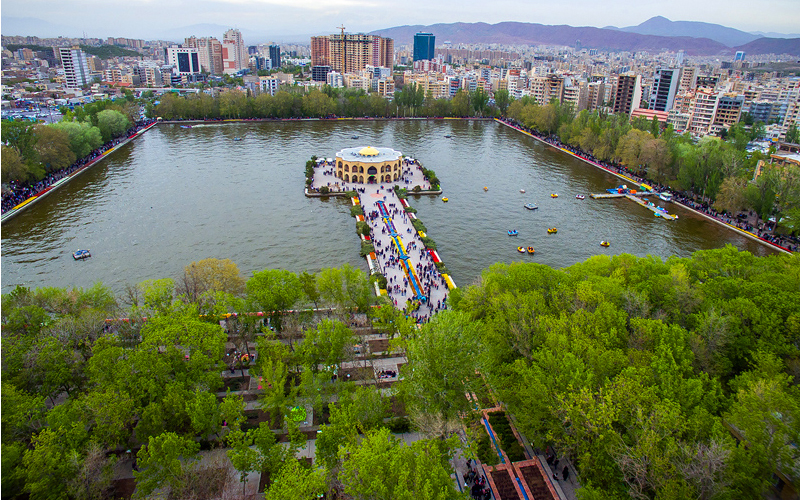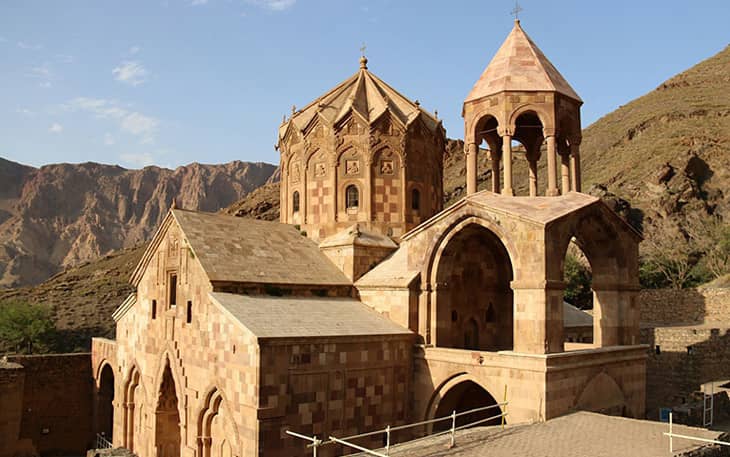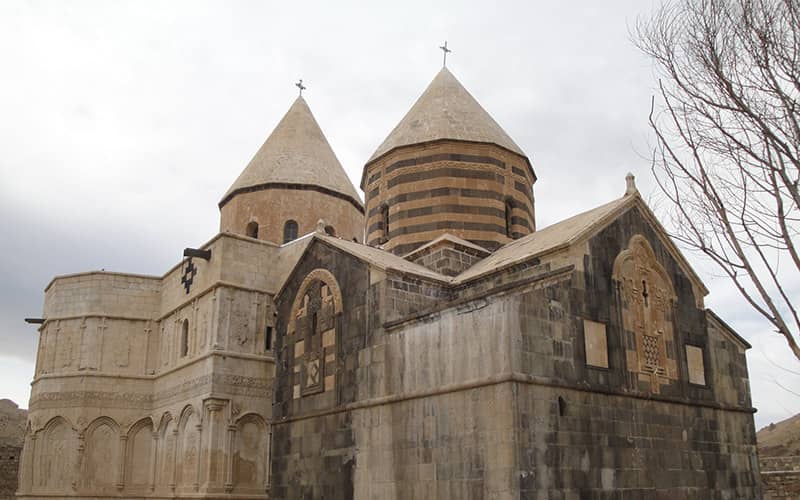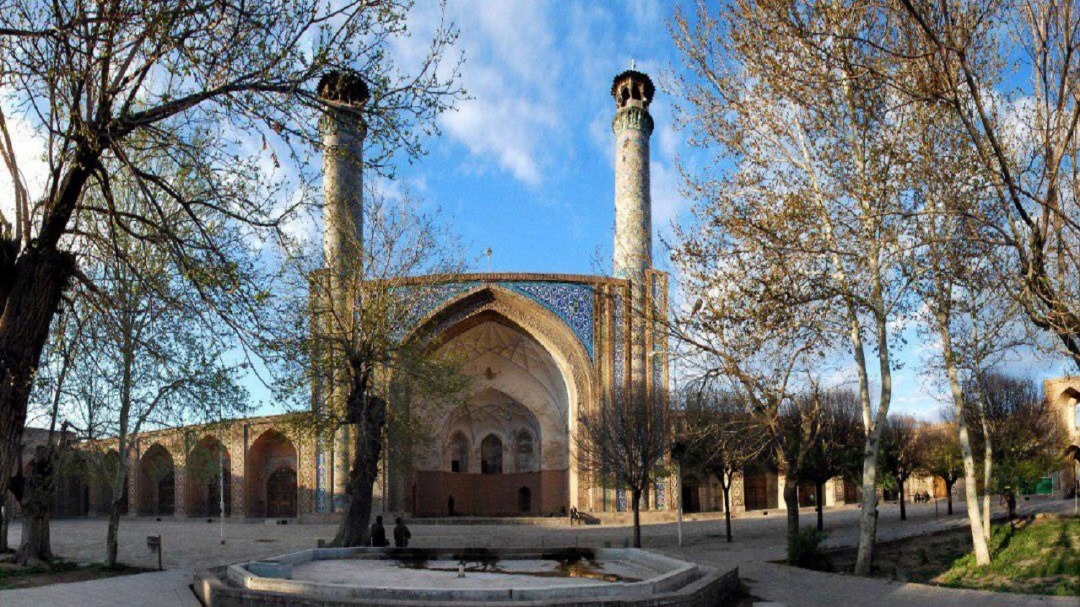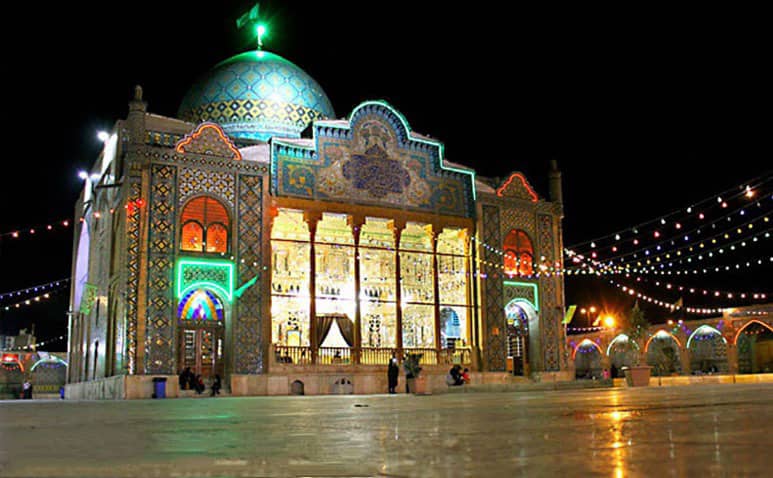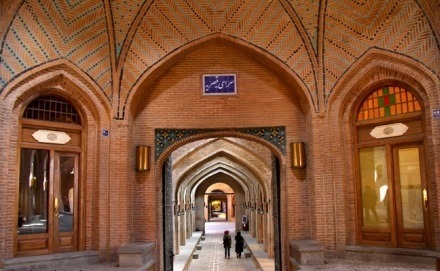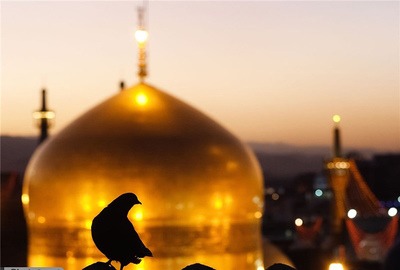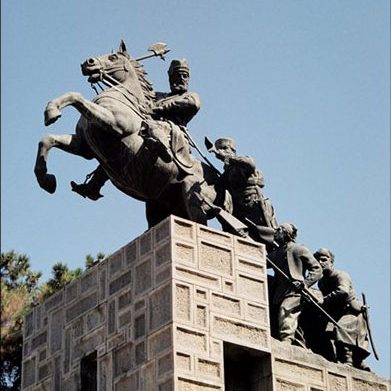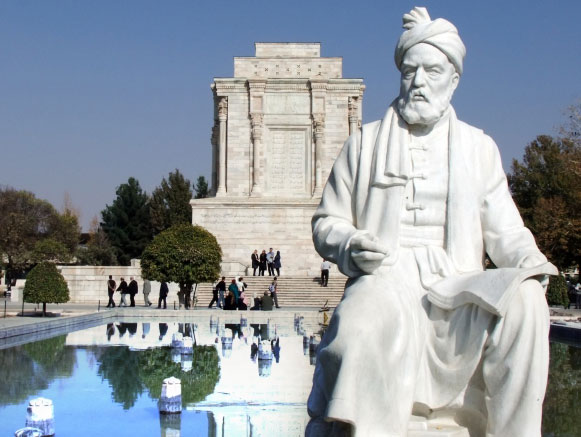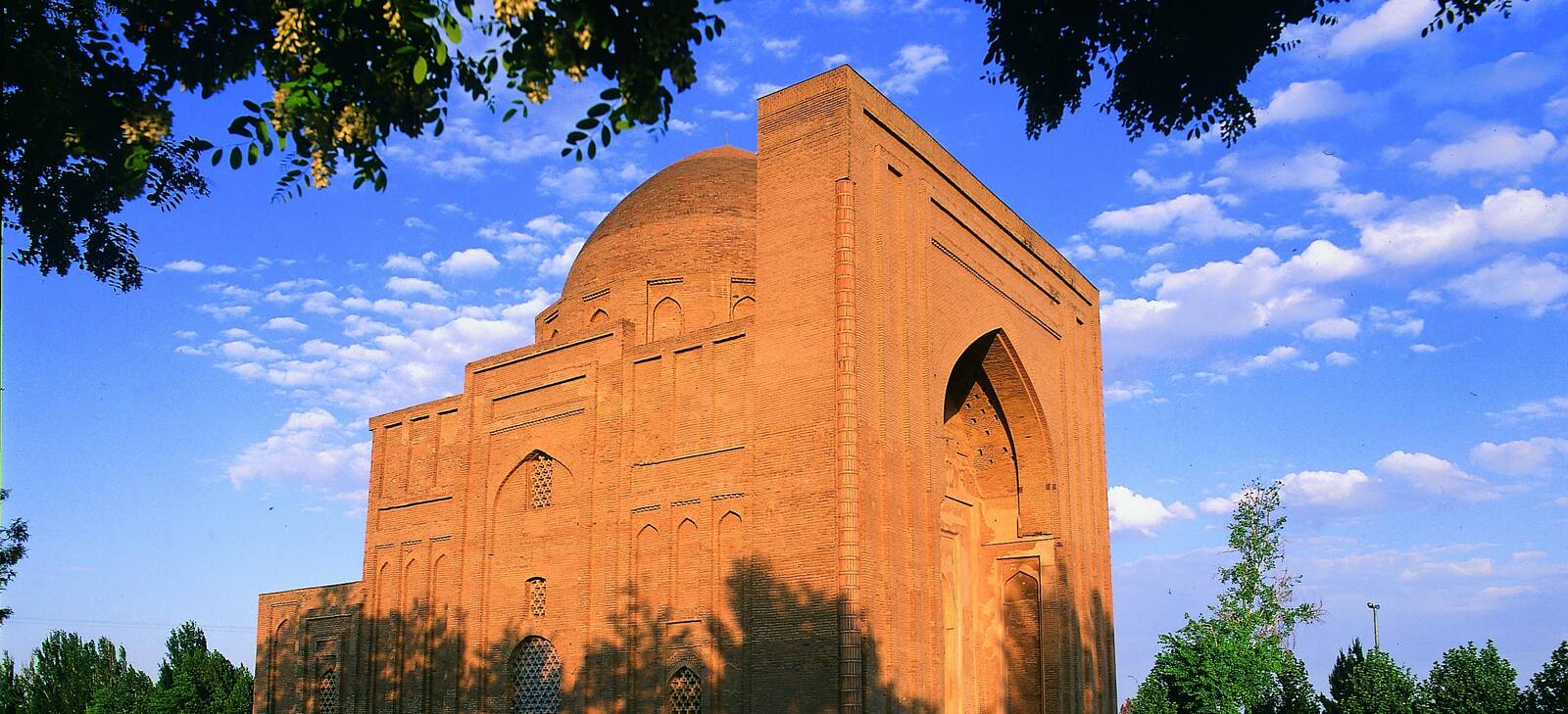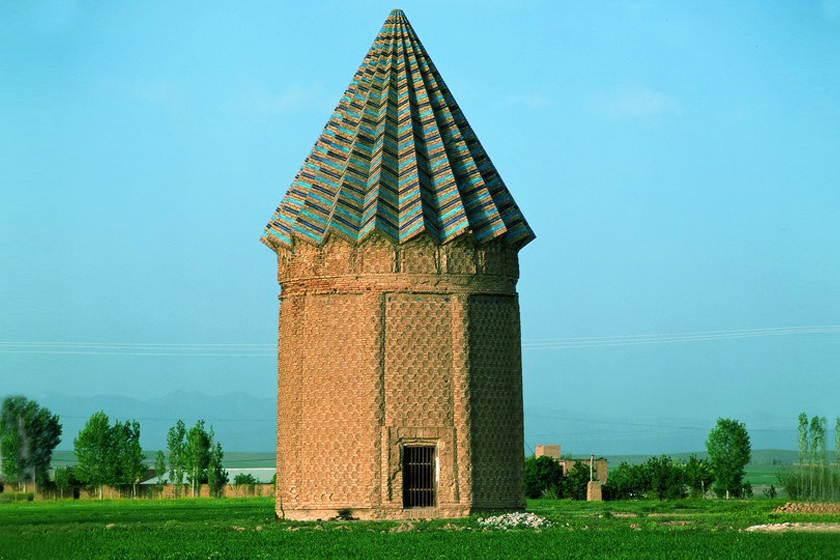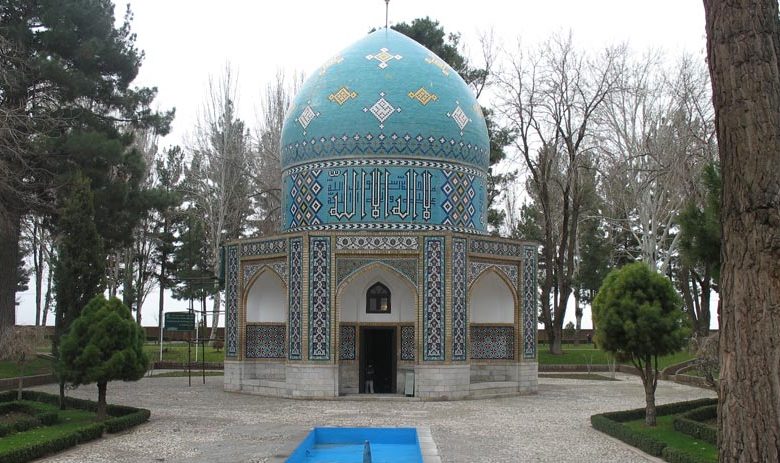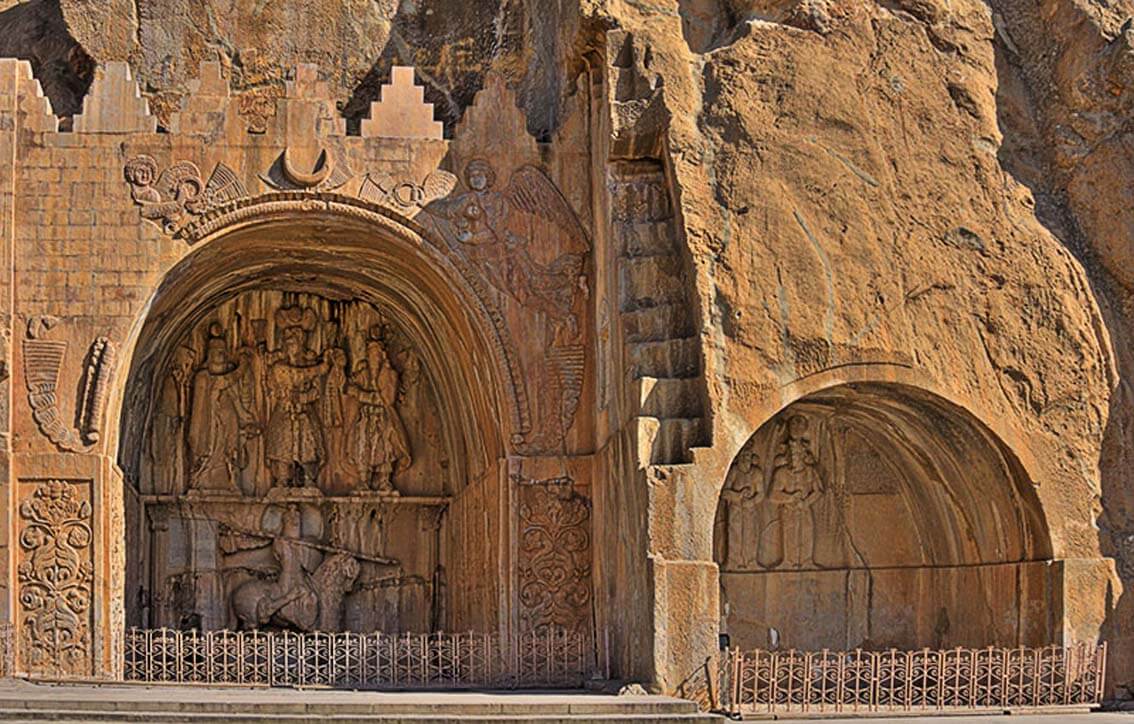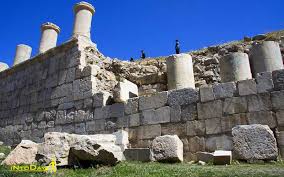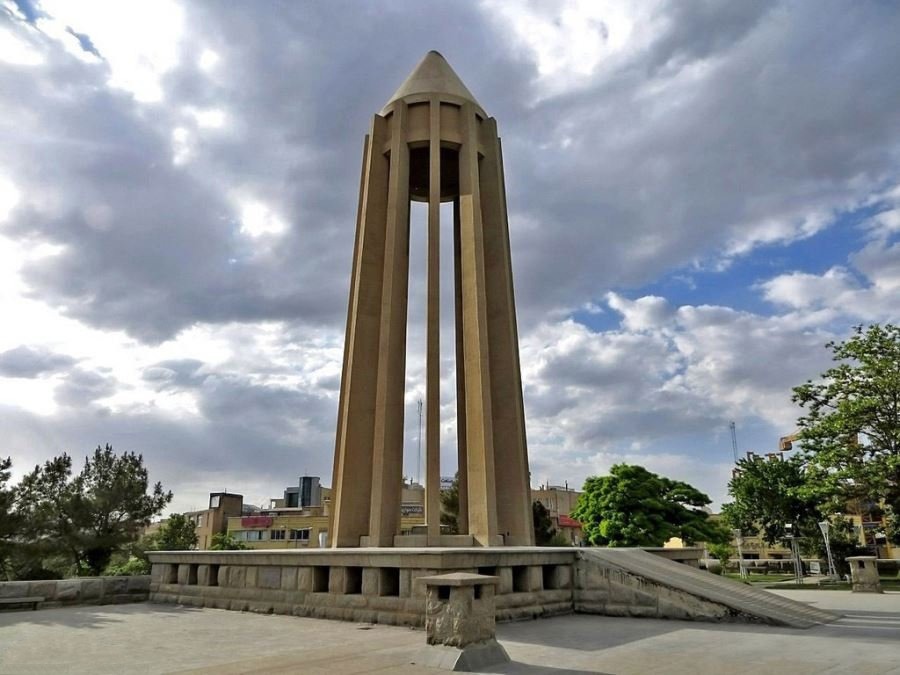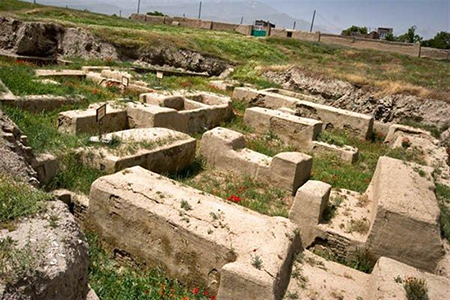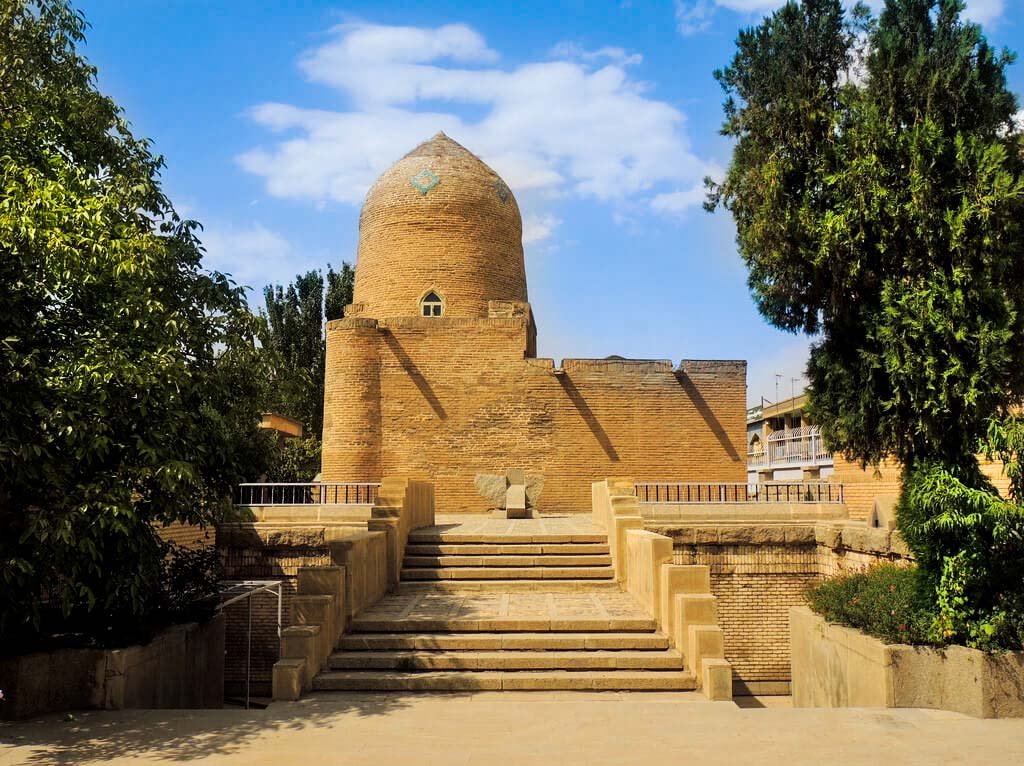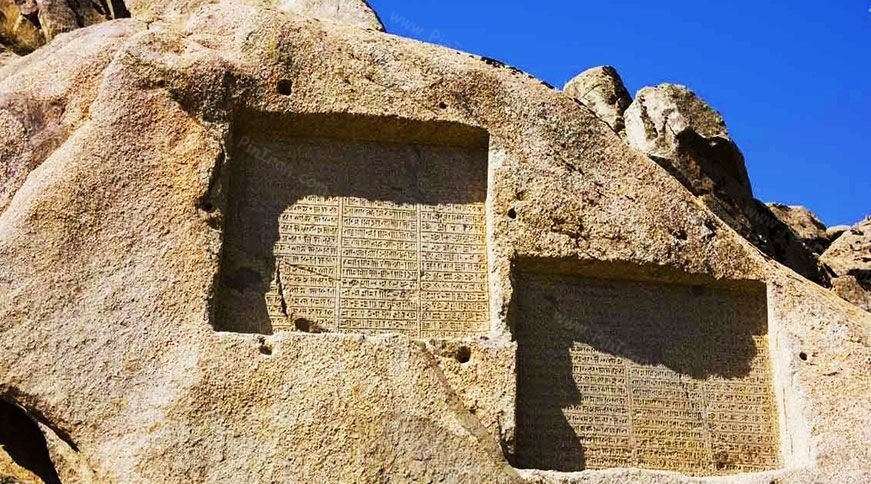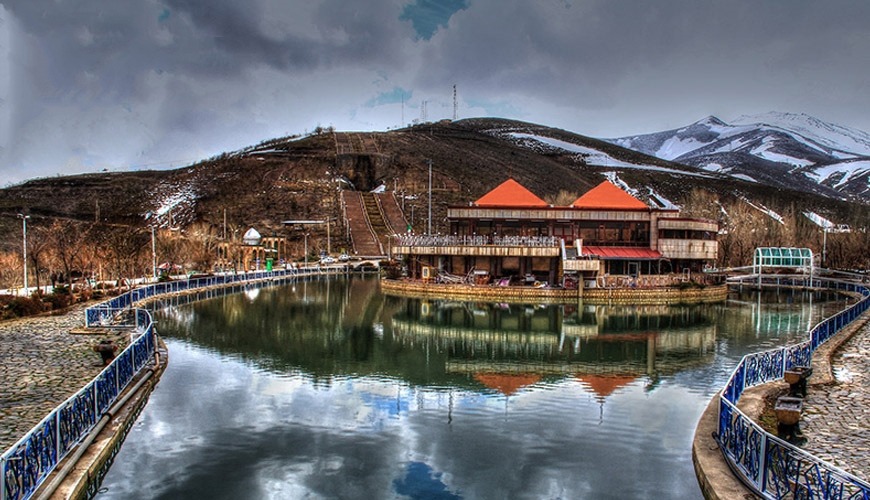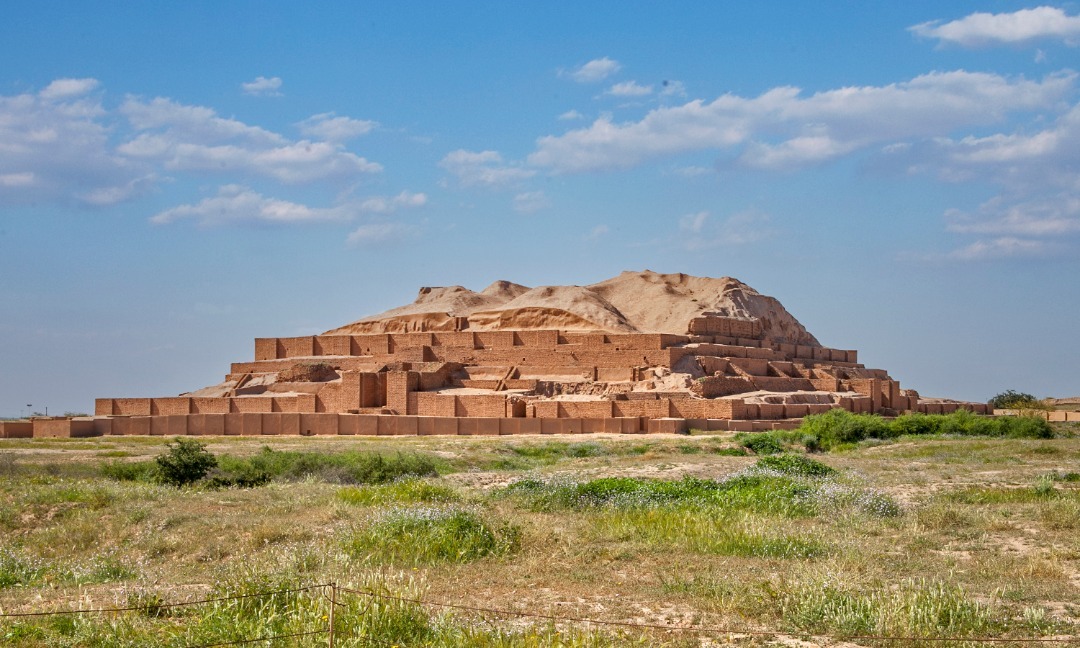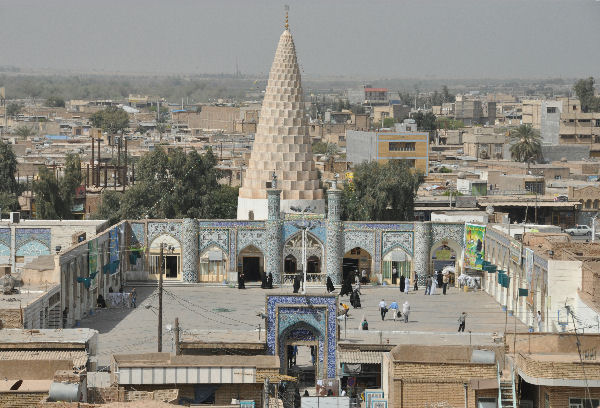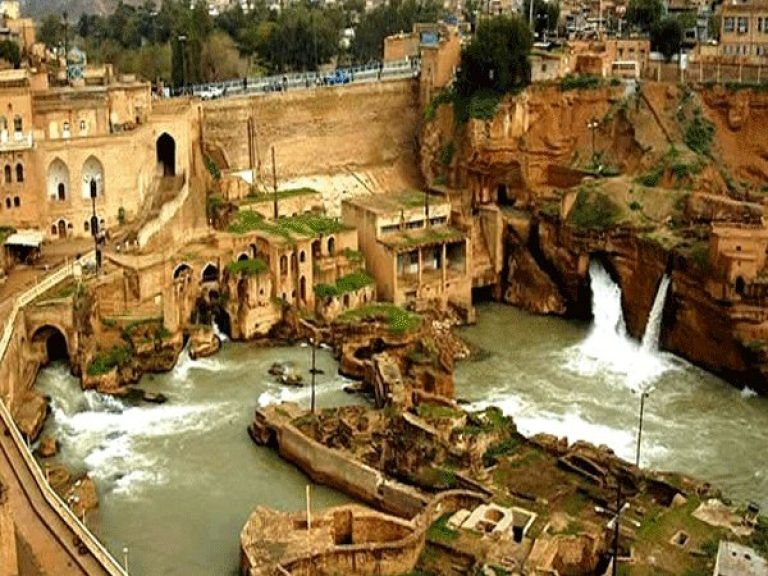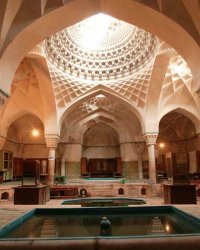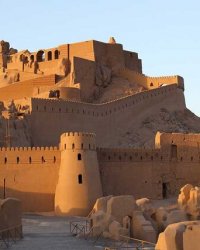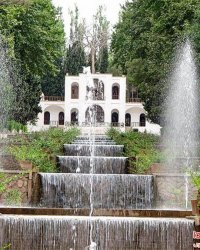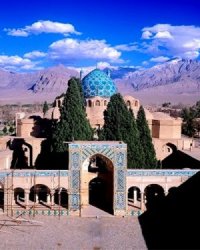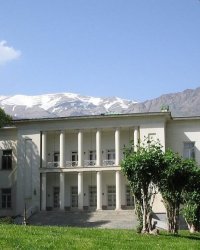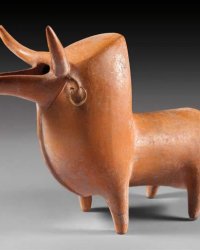Zanjan
Zanjan
Zanjan is the capital of Zanjan Province in Iran. It lies 298 km north-west of Tehran on the main highway to Tabriz and Turkey and approximately 125 km from the Caspian Sea. At the 2016 census, its population was 521,302 which is the 20th largest city in Iran. The population of Zanjan consists mostly of Iranian Azeris who can also speak the Azerbaijani language.The entire province has 21,733 square kilometers.
Zanjan is known for its handcrafts such as knives, traditional sandals, called charoogh, and malileh, a handcraft made with silver wires. Zanjani artists make many things like various decorative dishes and their special covers as well as silver jewelry. In ancient times, Zanjan was known for its stainless and sharp knives. But this tradition is gradually becoming extinct by introduction of Chinese-made knives into the market which are far cheaper, more abundant and less artistic. Many villagers today are traditional carpet weavers. Zanjan’s population boasts the highest level of happiness among the people of 30 other provinces in Iran.
Hamdollah Mostowfi, the Iranian traveler and historian, in his book claims that Zanjan was built by Ardashir I, the first king of the Sassanid Empire and named as “Shahin”.One important moment in the history of the city was in 1851 when the city became a center for the suppressed Babi religious movement, along with Neyriz and a fortress known as Shaykh Tabarsi. The forces of the central government captured the Babi fort in Zanjan after a long siege on the orders of Grand Vizier (Prime Minister of Iran) Amir Kabir and killed or expelled the Bab’s followers.
According to the Food and Agriculture Organization (FAO) of the United Nations, rainfed agriculture makes up around 42% of Zanjan’s land cover and grasslands account for another 37%. The remainder is bareland, irrigated agriculture, forest, orchard and riverbanks. Only 1.07% of the land is urban development.
You need at least 1 day to visit:
The Dome of Soltaniyeh is a complex of ruins centering on the Mausoleum of the Mongol ruler Il-khan Öljeitü, also known as Muhammad Khodabandeh.
The main building, erected between 1302 and 1312 AD, it may be compared to that of Brunelleschi’s cupola for Christian architecture. It is one of the largest brick domes in the world, just at the theoretical engineering limit for a brick dome and the third largest dome in the world after the domes of Florence Cathedral and Hagia Sophia. The Dome of Soltaniyeh paved the way for more daring Iranian-style cupola constructions in the Muslim world, such as the Mausoleum of Khoja Ahmed Yasavi and the Taj Mahal. Much of its exterior decoration has been lost, but the interior retains superb mosaics, faience, and murals. People have described the architecture of the building as “anticipating the Taj Mahal.”
The estimated 200 ton dome stands 49 meters tall from its base, and is currently undergoing extensive renovation.
Arghun, the Ilkhanid ruler of Iran at the time, established the Sultaniyya as his summer capital. His son, Muhammad Oljeitu Khudabanda, furthered the city’s development and transformed it into the capital of the empire. After Oljeitu’s death, the city began a steady decline, and from a once flourishing city it now only has two buildings which show signs of its former wealth and importance, an octagonal tomb and an adjacent khanaqah. A khanaqah is a building designed specifically for Sufi gatherings as a spiritual retreat. The strong quality of the preserved tomb attests to the richness of its patronage.
The Tomb of Oljeitu was utilized for multiple functions, such as Quran reading, praying, teaching, housing, and medical purposes. The main building is approximately 38 m across and is crowned by a dome with an average diameter of 24m. The tomb is highly visible, due to its unique incorporation of eight minarets enclosing the dome above the gallery. More specifically, Oljeitu’s complex consists of four iwans connected by arcades with muqarnas surrounding the perimeter of a courtyard; this was considered the classic Iranian style. The tomb itself stands behind the southern iwan. Furthermore, the iwans were all plastered and painted, and the courtyard was paved with white marble.
As for the interior of the tomb, it is decorated in tile and plaster. The underside of the iwans are stuccoed with bands of ornamentation, that were later painted. A significant inscription–spotted with ogival forms sculpted over cloth–circles the entire dome. The galleries have low, wooden or marble railings. The windows are fitted with bronze screens, along with bronze knobs and balls set with gold and silver.Some elements from these window grilles were inscribed with their patron’s name or with detailed scenes, such a depictions of a horseman or of falconry.
Historical Edifice of Rakhtshooy Khaneh which translates to wash-house lies at the historical texture of the Zanjan city and it was built nearly 20th century. This place was used for washing clothes by women around the city. It was constructed by two brothers named Mashad Akbar and Mashadi Esmail, Akbar was an architect and Esmail was a stone mason. This historic building is currently being used as Zanjan Anthropological Museum.
Tabriz
Tabriz
hier is more about city of Tabriz
Tabriz is the former capital and the main city of the Azerbaijan region of Iran and its inhabitants are speakers of the Turkish dialect. It is the 2nd city after Tehran where the decisive battles took place during the major socio-political events of the country during the 19th and at the beginning of the 20th century. Like the drafting and establishment of the constitution and other liberating events during the Qajar monarchy.
Throughout its history, Tabriz has suffered so much damage from natural disasters as it has from invading enemies.
For centuries the city was the only access to the Western world. it was the great gate through which overland trade took place. Tabriz played this role until the Suez Canal came into effect and the sea lanes were used. Thanks to its geographical location and the kinship ties with the people of neighboring countries, especially Azerbaijan and Turkey, the inhabitants have been able to develop smooth and solid trade relations. A lot of goods pass through Tabriz, but also, new ideologies and currents of intellectual thought, such as communism and democratic socialism have been able to penetrate the country.
The customs benefit exclusively granted to the Russians was a matter of greed for the British. The state to satisfy the English had given them the same advantage on the southern border.
The famous Blue Mosque collapsed in an earthquake, brought back to life thanks to a well-carried out restoration, opens the visit of the city. The Azarbaijan Museum is next door, then we set off to visit Iran’s most beautiful bazaar where merchants are grouped into corporations.
There are many possibilities for excursions to nearby sites. As first of all the village of Kandovan, an hour’s drive away, and the visit of its cave houses still inhabited. For those interested in the history of Christianity and the Gregorian faith, several famous Armenian churches are in the area.
A long day of excursion to discover the Church of Saint Stéphanoise and the Church of Saint Tadee (Kara – kelissa), it will be an unforgettable pilgrimage.
You need at least 1 day to visit:
Tabriz Historic Bazaar Complex consists of a series of interconnected, covered, brick structures, buildings, and enclosed spaces for different functions. Tabriz and its Bazaar were already prosperous and famous in the 13th century, when the town, in the province of Eastern Azerbaijan, became the capital city of the Safavid kingdom. It is one of the most complete examples of the traditional commercial and cultural system of Iran
The Blue Mosque (Masjed-e Kabūd) is a historic mosque in Tabriz, Iran. The mosque and some other public buildings were constructed in 1465 upon the order of Jahan Shah, the ruler of Kara Koyunlu.
The mosque was severely damaged in an earthquake in 1780, leaving only the iwan (entrance hall). Reconstruction began in 1973 by Reza Memaran Benam under the supervision of Iranian Ministry of Culture.
Azerbaijan Museum is the major archaeological and historical museum in Tabriz, in the northwest part of Iran (East Azerbaijan Province). It was established on April 1958. The museum consists of three major halls, a side yard, office rooms and a library. It mostly contains objects discovered from excavations in Iranian Azerbaijan, also some artworks and sculptures of artists. Its library contains more than 2500 books, both handwritten and printed, about history, archaeology, art and Iranian culture. Apart from National Museum of Iran in Tehran, Azerbaijan Museum has the largest collection belonging to different periods of Iran’s history.
The Jāmeh Mosque a large, congregational mosque (Jāmeh) in Tabrīz city, It is located in the Bazaar suburb of Tabriz next to the Grand Bazaar of Tabriz.
El Gölü also called Shah Goli is a large historic park (or garden) in the south east region of Tabriz. One of its main features is its large artificial lake, measuring 210 meters on sides.
Tradition dates the construction of the park to the late 18th century However, it may have been built earlier as well; some sources suggest as far back as the 14th century.In the Qajar period the park was restored and high terraces were added.
The northern side of the lake was built up, which, according to Penelope Hobhouse, makes the lake “appear to float over the valley”.A causeway leads out to a pavilion, today the site of a restaurant. The pavilion was once crowned with a dome.From the west hillside, a spring feeds the lake, a cascade descending in five terraces. The sight is flanked by poplar trees and willows.
Kandovan is an ancient village in Sahand Rural District in the Central District of Osku County, East Azerbaijan Province. It is situated in the foothills of Mount Sahand, near the city of Osku. At the 2006 census, the village population was 601, in 168 families.
The village exemplifies manmade cliff dwellings which are still inhabited. The troglodyte homes, excavated inside volcanic rocks similar to dwellings in the Turkish region of Cappadocia, are locally called Karaan. Karaans were cut into non-welded ignimbrites, also called “ash-flow tuffs,” of Mount Sahand. The cone form of the houses is the result of the erosion of ignimbrite layers consisting of porous, round and angular pumice together with other volcanic particles that were positioned in a grey, acidic matrix. During the eruption of Sahand, pyroclastic flows formed the rocks of Kandovan. Around the village the thickness of this formation exceeds 100 metres and with time, due to water erosion, the cone-shaped cliffs were formed.
1 more day to visit:
Qazvin
Qazvin
in Qazvin You need at least 1 day to visit:
The oldest part of jame mosque of Qazvin is said to have been constructed by the orders of Harun al-Rashid in 807CE. Later additions were made, the last being during the late Safavid era. The double layered main dome of the mosque is from the Seljuk era, and is locked to the public. It houses some precious examples of relief calligraphy from medieval times. Renovations have also been carried out on many sections of the mosque.
The foundation of the mosque is laid on a Zoroastrian fire temple.
In spite of the devastating Mongol invasion, the mosque still stands today in its full glory. It is still in use. Parts of the mosque have been turned into a public library.
The mosque also contains a Shabestan (parayer hall) and Ab anbar (water reservoir), both now under the protection of Iran’s Cultural Heritage Organization.
Part of the complex caught fire on 28 January 2013. Half of the complex was burnt and destroyed by the fire.
The Imamzadeh Hossein is the grave mosque of a son of the 8th Imam Ali al-Ridha in Qazvin, Iran that the Safavids – Shah TahmaspI built in the mid-16th century as a pilgrimage center.
The namesake of the tomb is the biennial deceased son of Imam Hossein. This passed in transit with his father to Khorasan in Qazvin in 821 and was buried at the site. Later more people were buried from the Safavid dynasty bib. Tahmasp I, who had his seat of government in Qazvin, built the tomb. His daughter Zeynab Begum expanded it in 1630, as is testified by a tile inscription.
The Sa’d al-Saltaneh Caravanserai is a large Caravanserai located in the city of Qazvin.
Built during the Qajar era, the caravanserai is one of Persia’s best preserved urban caravanserais. The builder (patron) of this large caravanserai was a person by the name Sa’d al-Saltaneh Isfahani for whom the caravanserai is named after.
The caravanserai is built on a square plan, has 4 iwans facing a courtyard. The interiors are decorated with Muqarnas and Rasmi bandi.
The Hujrehs, or the rooms for the travelers, are situated one meter above the courtyard ground level. The Hashti behind the southern iwan has the largest gonbad, with 4 semi-domes adjacent to it.
1 more day to visit:
Alamut is located 150 km in the northeastern of Qazvin and is built on top of a high rock reaching 2163 m above sea level near the Gazor Khan Village. The rock is 200 m high and covers an area of 20 hectares; with its steep slope and deep and dangerous ravine, the rock is practically inaccessible and forms a part of the fort’s structure. Currently, only ruins of the fort and some towers are apparent, and it is only through archaeological excavation that the main portions can be discovered.
In 1090 CE, Hassan-i Sabbah, the leader of the Assassins, a sect of Nizari Ismailis in Iran, chose the Alamut region as his headquarters to campaign, preach and convert new followers.
Mashhad
Mashad
Mashhad
Mashhad is the second most populous and the most religious city in Iran and capital of Razavi Khorasan Province. It is located in the northeast of the country, close to the borders of Turkmenistan and Afghanistan.
It was a major oasis along the ancient Silk Road connecting with Merv in the East.
The city is most famous and revered for housing the tomb of Imam Reza, the eighth Shia Imam. Every year, millions of pilgrims visit the Imam Reza shrine and pay their tributes to Imam Reza.
ity’s economy is based mainly on dry fruits, salted nuts, saffron, Iranian sweets like gaz and sohaan, precious stones like agates, turquoise, intricately designed silver jewelry studded with rubies and emeralds, eighteen carat gold jewelry, perfumes, religious souvenirs, trench coats, scarves, termeh, carpets and rugs.
You need at least 1 day to visit Mashhad
Mashhad has a complex which contains the mausoleum of Imam Reza, the eighth Imam of Twelver Shias. It is the largest mosque in the world by area. Also contained within the complex are the Goharshad Mosque, a museum, a library, four seminaries,a cemetery, the Razavi University of Islamic Sciences, a dining hall for pilgrims, vast prayer halls, and other buildings.
more than 25 million Iranian and non-Iranian Shias visiting the shrine each year.
Goharshad Mosque,
This mosque was constructed by Goharshad (the wife of Shahrokh Teimoori), in 1418 a.c. This mosque has a large courtyard in the center with four porticos. Beautiful inscriptions in Thulth script (the work of Shahrokh’s son) adorn the walls. The most important section of this mosque is its southern portico.
In bombardments of the Russian forces in 1912 a.c . the main dome of this mosque which was 15m. in dia. sustained a loss. This dome was demolished in the year 1921 a.c , The current dome has been constructed with concrete. This mosque has gone under repair once during the Safavid reign and the other in the Qajar era.
Nader Shah Afshar (August 1688[5] – 19 June 1747) was one of the most powerful Iranian rulers in Iranian history, ruling as Shah of Iran (Persia) from 1736 to 1747 when he was assassinated during a rebellion. Because of his military genius as evidenced in his numerous campaigns throughout Middle East, Caucasus, Central and South Asia, such as the battles of Herat, Mihmandust, Murche-Khort, Kirkuk, Yeghevard, Khyber Pass, Karnal and Kars, some historians have described him as the Napoleon of Persia, Sword of Persia or the Second Alexander. Nader belonged to the Turkoman Afshar tribe, a semi-nomadic tribe settled in Khorasan in northeastern Iran, which had supplied military power to the Safavid dynasty since the time of Shah Ismail.
Abul-Qâsem Ferdowsi Tusi or just Ferdowsi was a Persian poet and the author of Shahnameh (“Book of Kings”), which is one of the world’s longest epic poems created by a single poet, and the national epic of Greater Iran. Ferdowsi is celebrated as one of the most influential figures of Persian literature and one of the greatest in the history of literature.
The tomb was built in 1934 in Pahlavi period.
Haruniyeh is an unknown and mysterious monuments and the only monument remaining from the ancient Tus City. This monument is 20 kilometers from the North West of Mashad .
The interior space includes the porch entrance, four daises, dome and three minor rooms and all these parts are seen in public. In the exterior space, there is a small memorandum tombstone from Imam Mohammad Ghazali and a big rectangular garden is also built in front of Haruniyeh Porch according to the plans and designs. There are different ideas about the date of Haruniyeh construction and it dates back to about eighth and seventh Hijri centuries and even to the time before that. Some recognize it a monastery and teaching place of Imam Mohammad Ghazali that was built before the attack of Mongols. Some others call the monument the prison of Harun.
A tower-like building of 17 meters high can be seen 20 kilometers from the northern part of Mashhad and on the borders of Tus Road that according to some people, a great battle was taken place between the previous governors of Khorasan and Sultan Mahmoud Ghaznavi. The architectural plan of the rod dates back to Timurid era and the Nineth Hijri century.
This tower is a tomb which is located on an eight half-sided circular platform
1 more day to visit:
Kermanshah
Kermanshah
Kermanshah
Kermanshah, and its predominantly Kurdish population, with some Lor is in northwest Iran.
The city, being the capital of the northwest region, served as a supply base for the northern front against the Iraqi assault and was severely hit during the Iran-Iraq war.
Kermanshah is located on the ancient road that connects the Iranian plateau to the Mesopotamian plain. The latter is punctuated by numerous ornamentations and archaeological remains from different periods: Achemenides, Hellenistic, Parthian and Sassanid.
There, in Behistoun, located 20km from Kermanshah, the statue of the Greek hero Hercules who seems to watch over her. On the same rock where this work was carved, appears the proclamation of Darius I written in three languages: Old Persian, Elamite and Akkadian, and which tells us of his illustrious conquests.
Among other vestiges of antiquity, one can find the temple dedicated to the veneration of Artemis, Anahita in the Persian pantheon, 100 km away, in the city of Kangavar.
Nowadays, this route is mainly used by Shia pilgrims from Iran and Iraq.
In Tagh e Bostan we visit the jubilant scene of the Sassanid kings, which offers a style different from the art already known to the Sassanids, the hunting scenes presented as a comic strip with unprecedented realism and incredibly detailed.
The statues with rounded shapes are unheard of in the Sassanid artistic repertoire, and the structure of the bas-reliefs and the halos adorning the busts evoke the influence of Buddhism at that time.
A Tekiey, a place reserved for the commemorative processions of the mourning of Imam Hossein, dating from the 19th century offers a very fine example of Qajar period tiles, very well preserved.
This region is rich and fertile, which favors agriculture. In addition, it is renowned for its traditional cookies.
You need at least 1 day to visit:
Bisotun is located along the ancient trade route linking the Iranian high plateau with Mesopotamia and features remains from the prehistoric times to the Median, Achaemenid, Sassanian, and Ilkhanid periods. The principal monument of this archaeological site is the bas-relief and cuneiform inscription ordered by Darius I, The Great, when he rose to the throne of the Persian Empire, 521 BC. The bas-relief portrays Darius holding a bow, as a sign of sovereignty, and treading on the chest of a figure who lies on his back before him. According to legend, the figure represents Gaumata, the Median Magus and pretender to the throne whose assassination led to Darius’s rise to power. Below and around the bas-reliefs, there are ca. 1,200 lines of inscriptions telling the story of the battles Darius waged in 521-520 BC against the governors who attempted to take apart the Empire founded by Cyrus. The inscription is written in three languages. The oldest is an Elamite text referring to legends describing the king and the rebellions. This is followed by a Babylonian version of similar legends. The last phase of the inscription is particularly important, as it is here that Darius introduced for the first time the Old Persian version of his res gestae (things done). This is the only known monumental text of the Achaemenids to document the re-establishment of the Empire by Darius I. It also bears witness to the interchange of influences in the development of monumental art and writing in the region of the Persian Empire. There are also remains from the Median period (8th to 7th centuries B.C.) as well as from the Achaemenid (6th to 4th centuries B.C.) and post-Achaemenid periods.
Taq-e Bostan means “Arch of the Garden” or “Arch made by stone” is a site with a series of large rock reliefs from the era of the Sassanid Empire of Persia (Iran), carved around the 4th century CE.
This example of Persian Sassanid art has endured almost 1,700 years of wind and rain. Originally, several sources were visible next to and below the reliefs and arches, some of which are now covered. Sources next to the reliefs still feed a large basin in front of the rock. The site has been turned into an archaeological park and a series of late Sassanian and Islamic column capitals have been brought together (some found at Taq Bostan, others at Bisutun and Kermanshah).
The carvings, some of the finest and best-preserved examples of Persian sculpture under the Sassanids, include representations of the investitures of Ardashir II (379–383) and Shapur III (383–388). Like other Sassanid symbols, Taq-e Bostan, and its relief patterns accentuate power, religious tendencies, glory, honor, the vastness of the court, game and fighting spirit, festivity, joy, and rejoicing.
The Anahita Temple is a sites in Kangavar city popularly thought to has been attributed to the ancient deity Anahita.
The remains at Kangavar reveal an edifice that is Hellenistic in character, and yet display Persian architectural designs. The plinth‘s enormous dimensions for example, which measure just over 200m on a side, and its megalithic foundations, which echo Achaemenid stone platforms, “constitute Persian elements”.This is thought to be corroborated by the “two lateral stairways that ascend the massive stone platform recalling Achaemenid traditions”, particularly that of the Apadana Palace at Persepolis.
Tekyeh Moaven al-molk is a Tekyeh and historical place to commemorate the mourning of Hossein the grandson of prophet of Islam. It was built during Qajar era as a Shia mourning site. It is well known for its exclusive tiling, picturing Islamic era Ghazi (warrior), Battle of Karbala and Iranian kings such as Achaemenid kings and Persepolis. It has three main parts: Hussainiya, Zaeynabiya and Abbasiya. Museum of Anthropology of Kermanshah, and Clothes and Jewelry Museum of Kermanshah are located in Abbasiya.
Hamedan
Hamadan
Hamedan
Hamedan is the ancient capital of the Medes kingdom, the predecessors of the Persians of the same Indo-Iranian lineage.
The remains of Hegmataneh, so the city was called in Antiquity, can be visited at the archaeological site under the same name in the city without any trace of 7 legendary walls surrounding the city is found, each one had to be colored differently, one gold the other silver according to Herodotus.
The city was on the royal road to Mesopotamia and the decisive defeat of the Sassanids against the Muslim army in 636 A.D., which turned the page in Persian history, happened at Nahavand 110 km away.
Its geographical location makes an ethnic crossbreeding, the population being mixed with Kurds, Turks, and Lurs and Laks presents a demographic wealth.
The great scholar and philosopher Avicenna was to find his composure here and the two biblical figures Ester (wife of Achaemenid king Xerxes) and his uncle Mourdekhay, a courtier, were buried in a humble mausoleum in the city center.
To integrate the old circular city plan into a new modern architecture, the German engineer in charge of the project, created a central roundabout from which 6 arteries going through the city started, the double arcade square has 12 small domes.
The other surviving site from the ancient times, Ganj-Nameh (the treasure map) called by the locals, takes us to the foot of Mount Alvande (3510 m) which dominates the city. The site has two inscriptions of Darios and Xerexes in cuneiform noting the family tree of Darios in order to justify his Achaemenid lineage. In the end of the day The tepe of Abass-Abad offers a panoramic view of the city.
Hamedan is known for its ceramic designs and a palette typical of the region.
You need at least 1 day to visit:
Avicenna
Ibn Sina also known as Abu Ali Sina and often known in the West as Avicenna (c. 980 – June 1037), was a Persian polymath who is regarded as one of the most significant physicians, astronomers, thinkers and writers of the Islamic Golden Age, and the father of early modern medicine. Sajjad H. Rizvi has called Avicenna “arguably the most influential philosopher of the pre-modern era”.He was a Muslim Peripatetic philosopher influenced by Greek Aristotelian philosophy. Of the 450 works he is believed to have written, around 240 have survived, including 150 on philosophy and 40 on medicine.
His most famous works are The Book of Healing, a philosophical and scientific encyclopedia, and The Canon of Medicine, a medical encyclopedia which became a standard medical text at many medieval universities and remained in use as late as 1650.
Besides philosophy and medicine, Avicenna’s corpus includes writings on astronomy, alchemy, geography and geology, psychology, Islamic theology, logic, mathematics, physics and works of poetry.
The Tell Hagmatana, also called Tepe Hegmataneh (thought to correspond to the ancient citadel of Ecbatana) has a circumference of 1.4 kilometres with an area of about 40 hectares, which corresponds to a report from Polybius, although the ancient Greek and Roman accounts likely exaggerate Ecbatana’s wealth, splendor, and extravagance.[2] Relatively few finds thus far can be firmly dated to the Median era. There is a “small, open-sided room with four corner columns supporting a domed ceiling,” similar to a Median-era structure from Tepe Nush-i Jan, interpreted as a Zoroastrian fire temple.[4] Excavations have revealed a massive defensive wall made of mud-bricks, and dated to the Median period based on a comparison to Tepe Nush-i Jan and Godin Tepe. There are also two column bases from the Achaemenid period, and some mud-brick structures thought to be from the Median or Achaemenid period. A badly-damaged stone lion sculpture is of disputed date: it may be Achaemenid or Parthian. Numerous Parthian-era constructions attest to Ecbatana’s status as a summer capital for the Parthian rulers.[2] In 2006, excavations in a limited area of Hagmatana hill failed to discover anything older than the Parthian period, but this does not rule out older archaeological layers existing elsewhere within the 35-hectare site.[5]
Ecbatana was first excavated in 1913 by Charles Fossey.[6] Excavations have been limited due to the modern town covering most of the ancient site.[7] In 1969 the Ministry of Culture and Art began buying property on the tell in support of archaeology, though excavation did not begin until 1983. By 2007, 12 seasons of excavation had occurred.[8] The work on the tell is ongoing.
The Tomb of Esther and Mordechai is located in Hamadan, Iran. Iranian Jews believe it houses the remains of the biblical Queen Esther and her cousin Mordechai, and is the most important pilgrimage site for Jews in Iran, and was declared a World Heritage Site by the Iranian government in 2008. There is no mention of it in either the Bavli or the Jerusalem Talmud and the Iranian Jewish tradition has not been supported by Jews beyond Iran. It was built in Ilkhanat period 14 century.
Ganjnameh (lit. ’Treasure Book’) is located southwest of Hamadan (ancient Ecbatana) in western Iran, at an altitude of c. 2000 meters across Mount Alvand.The site is home to two trilingual Achaemenid cuneiform inscriptions. The inscription on the upper left was created on the order of Achaemenid King Darius the Great (r. 522–486 BC) and the one on the right by his son King Xerxes the Great (r. 486–465 BC).
The Abbas Abad Hill is located in a scenic area west of Hamedan city and at the foot of the Alvand Mountain range. This hill offers a beautiful view of the city and is a popular spot among locals. During World War II, the Germans created a pool on this hill to meet the water and electricity demands of the city. Today, a restaurant has been built at the center of this pool.
Ahvaz
Ahvaz
to know more Ahvaz
Abadan
Abadan is located in the southwest of Iran, 53 kilometres from the Persian Gulf, near the Iran–Iraq border. Abadan is 140 km from city of Ahvaz, the Khuzestan provinc’s capital.
City was ruined during the Iran–Iraq War (1980–88). The civilian population of the city dropped close to zero during the eight years of .The 1986 census recorded only 6 people. In 1991, 84,774 . the population today had jumped to almost 350,000 people. Abadan Refinery is one of the largest in the world. La population is mostly Arabic speaking.
You need at least 1 day to visit:
Tchoga Zanbil
the ziggurat of Tchoga Zanbil located in southwestern Iran, preserves the ruins of the holy city of the kingdom of Elam, founded around 1250 BC. J.-C.
the city of Tchoga Zanbil (Dur-Untash, the city of Untash in Elamite) was founded by King Untash-Napirisha (1275-1420 BC) to serve as the religious capital of the country. The main element of this ensemble is a gigantic ziggurat, a type of stepped pyramid monument, dedicated to the Elamite deities, Inshushinak and Napirisha.
Tchoga Zanbil (the basket-shaped mound named by the locals) was never completed and only a few priests lived there until its destruction by Assyrian king Ashurbanipal, c. 640 BC J.-C.
The ziggurat was decorated with a facing of cooked bricks, a number of which were decorated with cuneiform characters describing, in the Elamite and Akkadian languages, the names of the deities and
cursing those who would dare to destroy the sacred temple.
By chance, an airplane pilot working for a foreign oil company discovered the site while patrolling the area. French archaeologist Roman Ghirshman will be one of the first to excavate it at the beginning of the 20th century.
Among the peculiarities that make the originality of its architecture, we note the nested floors one in the other, the first examples of vaults, the angles of the building are in the 4 cardinal points (direction).
Iran, land of legends
The remains of the ancient city of Susa bear exceptional testimony to successive ancient civilizations during more than six millennia, as well as having been the capital city of the Elamite and Achaemenid Empires. It contains 27 layers of superimposed urban settlements in a continuous succession from the late 5th millennium BCE until the 13th century CE. Susa is on the most ancient of the sites, where the processes of urbanization crystallized in the late 5th millennium BC. A decade of scientific excavations from 1968 to 1978, and philological works at Susa, also documented the development and changing character of this early urban centre throughout the millennia.
The Tomb of Daniel is the traditional burial place of the Judeo-Islamic prophet Daniel.Various locations have been named for the site, but the tomb in Susa, Iran (Persia), is the most widely accepted, it being first mentioned by Benjamin of Tudela, who visited Asia between 1160 and 1163.
The current tomb was renovated and repaired in 1870 A.D. by order of Shia scholar Sheikh Jafar Shooshtari,
Shushtar watermills are built around the 3rd century AD. the ingenious mechanism made it possible to tame the water of the rivers of the region and to direct it towards a dike which fed more than 40 mills. The water was distributed by a system of valves which regulated an optimal flow rate for each mill.
Shushtar was a prosperous metropolis in its heyday. The remains of these constructions are, among others, the bridges built by the Roman prisoners, according to the know-how that we know well.
This city also served as a refuge for Nestorian Christians, persecuted by the Romans.
You need at least 1 day to visit:
Sheikh Lotfollah Mosque
Sheikh Lotfollah Mosque, a UNESCO World Heritage Site, is an architectural marvel and one of the most exquisitely decorated mosques in Iran.
Sheikh Lotfollah Mosque, a UNESCO World Heritage Site, is an architectural marvel and one of the most exquisitely decorated mosques in Iran. Arthur Upham Pope, the renowned American art historian, describes the mosque in these words: “it is hard to imagine this mosque is human-made and there is not even a small disadvantage on this building.” Standing on the eastern side of Naghsh-e Jahan Square, just across from the Ali Qapu Palace, it covers an area of about 2,500 square meters.
Sheikh Lotfollah Mosque was an integral part of Shah Abbas’ plan to convert Isfahan into the capital of Iran. Construction of the mosque began in 1602-3 AC and ended in 1618-19 AC.
As it is well-known, the mosque was mainly used as a private royal prayer hall. It is said that Shah Abbas I ordered the construction of a tunnel from Ali Qapu Palace to Sheikh Lotfollah Mosque to hide his harem from the eyes of strangers. However, no trace of this tunnel has ever been found in archeological excavations performed in Naghsh-e Jahan Square. A few years ago, a number of tunnels were found, but experts believe that they were used as ventilation ducts.
As a matter of fact, by placing Sheikh Lotfollah Mosque outside the palace compound and in front of Ali Qapu Palace, Shah Abaas I was going to take advantage of the symbolic value of crossing the public space by the royal family: a performative representation of the royal piety. Association of the mosque with the revered Shiite scholar, Sheikh Lotfollah, the man who lends his name to the royal-chapel mosque, is a firm confirmation of this interpretation. But who was Sheikh Lotfollah?
The Architecture of Sheikh Lotfollah Mosque
Apart from its stunning beauty, Sheikh Lotfollah Mosque has a number of other characteristics which makes it unique. For example, the mosque lacks minarets and courtyards commonly associated with Iranian mosques.
Like Qeysarie Bazaar and Jame Abbasi Mosque, the facade of the mosque was made to be flush with the inner corridor of the square. The lower part of the mosque’s portal is constructed of marble, while its upper part is covered with haft-rangi (seven-colored) tiles with densely interlocking floral and vegetal motifs.
The portal also holds a tile inscription by Ali-Reza Abbasi, the master calligrapher of the period, mentioning Shah Abbas as the constructor of the mosque and also the completion date of the portal. Interestingly, Shah Abbas is referred to by such titles as Al-Mousavi and Al-Hosseini in this inscription, connecting him to the seventh and third Imams of Shia Muslims. Actually, the succession of the Imams is one of the fundamental tenets of the Shiite code, and so the Safavid kings claimed descendance from Imam Musa Ibn Jafar (the seventh of the twelve Shiite Imams) to authorize their rule as Shiite leaders.
Also, above a latticed window in the middle of the portal there is an inscription which reads as: “the essence of the greatness is to be at the service of the descendants of Imam Ali.” And you should know that Imam Ali is the first Imam of Shiite Muslims.
The dome of the mosque is covered partly by the portal, but do not let this fact stray your attention from this amazing dome. It is itself a wonder. Why? Let me tell you. Based on the time of the day and the angle of sun, the color of the dome changes; it would be pink at dawn, beige at noon and ochre at dusk.
Well, after ruminating the façade of Sheikh Lotgollah Mosque for some minutes, ascend the stairs in front of the portal to enter the mosque. Just like Jame Abbasi Mosque, the orientation of the mosque is skewed in relation to Naghsh-e Jahan Square, allowing the mosque conform to the Muslims’ direction of prayer or qibla. Therefore, upon entering the mosque, you will run into a shadowy corridor which wraps around the northern side of the mosque to provide a path into the prayer chamber. This clever trick allowed the architect to keep the mosque aligned with the square.
By the way, once you are in the corridor, stay there for some seconds and let your eyes get accustomed to the dim light. Little by little, you will come to appreciate the unparalleled beauty of blue tiles, lavishly decorated with floral and vegetal patterns. Take the corridor, and after two slight turns, you will enter the magnificent dome chamber. Consider yourself lucky, since if you had come to Isfahan during the Safavid period, the mosque was heavily guarded and there was no way for you the enter the mosque and enjoy this one-of-a-kind dome.
Just as you reach the gate of the chamber room, your eyes are involuntarily drawn up to be amazed by the most magnificent replica of the heavens made by man. At first glance, the dome resembles the colorful, exquisite designs embellishing a peacock’s tail, an effect achieved by using lozenge and round patterns.
Look more carefully, and there also appears a big, shining sun decorating the dome of Sheikh Lotfollah Mosque. The patterns repeat over and over again, getting smaller and smaller as the diameter of the dome reduces towards the apex. This single dome is 22 m wide and 32 m high, supported by the four walls surrounding the chamber dome. Each wall is about 1.6 m thick.
Another wonder of Sheikh Lotfollah mosque is the way the architect played with the interior space of the prayer chamber. Without grabbing the attention of the visitor, the square plan of the mosque is magically turned into an octagonal and then come squinches which support the circular dome.
The walls and the ceiling of the prayer chamber are covered by small pieces of mosaic, each one individually shaped and fitted into the astonishing patterns surrounding you. The prayer chamber is 18.8 m wide and with a little exercise of imagination, you would be able to imagine all the efforts which went into building this precious gem.
By the way, the four corners of the prayer chamber are decorated with tile inscriptions, each one representing a line (or Aye) from four chapters of the Quran: Al-Shams, Al-Bayyinah, Al-Layl, and Al-Infitar. The other two inscriptions on the eastern and western sides of the prayer room contain lines of poems in Arabic, attributed to Sheikh Bahai. As its name at the end of the eastern inscription shows, the calligrapher who wrote these inscriptions was Maestro Bagher Banna. The inscriptions on the northern and southern side of the prayer hall also include the names of Sheikh Bahai and Bagher Bana.
At the base of the dome, there are 16 lattice windows of double layered stucco, embellished with inlaid mosaic allowing subdued light enter the dome. Above and below these windows there are two more tile inscriptions written by Maestro Ali-Reza Abbasi in 1616.
The small mihrab of the prayer hall is also interesting in its own right. On the inner right and left sides of the mihrab you will find two small tile inscriptions. The right one reads as “the deed of a poor and humble man seeking God’s mercy,” and the left one, referring to the architect of the mosque, as “Mohammad Reza, the son of Master Hossein Banna Isfahani.” It is dated 1619.
When you are leaving the mosque, on the left side of corridor just before the entrance, there is a small wooden door. Pass the door, descend the stairs and you will find yourself in space called “Beit al-Sheta” or the “winter House.” As its name implies, the worshippers came here to pray during the winter, since the main prayer chamber above was too cold to let them be in presence of God without distraction.
Whenever you are in Isfahan, make sure to visit this unique tourist attraction. It would be an elevating experience. In addition, you can take very beautiful pics to put on your Instagram account.
Tehran
Tehran
Tehran, the capital of Iran since the 19th century, is now a megapolis of more than 14 million inhabitants. This is the scene where the politic events and social tumultes of the country have happened and made our contemporary history.
Rey, the ancient city which is mentioned in the historical texts is now one of its southern quarters, absorbed by the frenetic development of Tehran.
Its airports, universities and hospitals and commercial centers are the biggest and most modern in the country.
Otherwise, for the lovers of traditional shopping, a promenade in the bazzar and its galleries would be nice which is the longest of the country.
Tehran also offers its mountains, its ideal surrounding for walkers and ski lovers in winter.
Since the rural life is touched by the dryness and the lack of facilities for the necessary development in the small urban centers, exodus to the megapolis has been intensified specially after the Islamic revolution, without any appropriate urban development plan has been anticipated.
Tehran is the point of departure for the most tourists trips because the museums and palaces, allowing cultural and historical discussion topics to be explored for the rest of the journey.
Recently, the elegant architecture of modern bridge (Tabiat) became an attraction and the place for meetings of the youngs, and a scene of interactions between the travelers and the inhabitants.
Although, its inhabitants always complain of the pollution and its traffic but they like their city because it is dynamic and release a sense of energy.
For most Iranians, the ambiguous thought of the past politics, and the destiny in the front, The name if Tehran still bears a great deal of secrecy.

